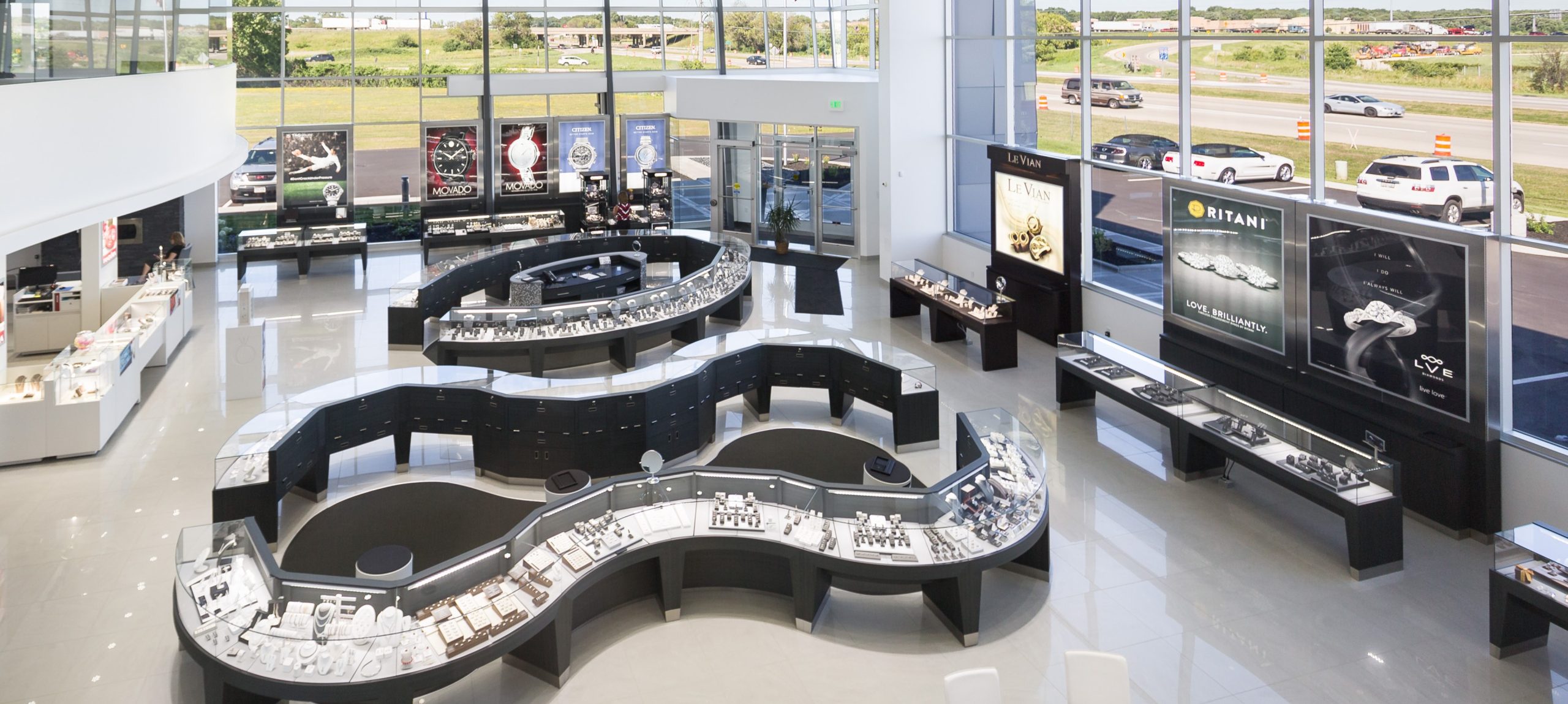Interior Design: Essential Aspects to Interior Space Planning for Jewelry Stores

Like any interior design project, planning the structure and appearance of a jewelry store involves considering several aspects and how they work together. The best jewelry designs are cohesive plans that meet the needs of every owner and accomplish the space’s ultimate job to be done–making a profit. When developing your jewelry store’s design, consider each of the following areas:
Planning a store’s build out and floor plan includes determining how much space to allocate for various purposes such as storage, staff facilities, administrative offices, POS counters, and cabinetry displays. The arrangement of permanent and moveable walls, display pieces, counters and other parts of the store affect how people move through it. A jewelry store must facilitate smooth traffic flows while also encouraging shoppers to stop and look. Good sight lines for employees and easy access to POS are also important factors to consider.
The jewelry store’s design will also need to provide room for its hidden but critical infrastructure, including framing for lighting, security cameras, audio and other devices, as well as electrical and data lines. Modern shoppers expect full connectivity even when shopping in-person. Modern jewelry stores need the infrastructure to support sophisticated displays, and self-service kiosks.
The graphic design of a jewelry store’s walls, display units and signage, along with its color scheme and other visual components, have a significant impact on the space’s overall message and how people experience it. For example, some smaller and older jewelry stores may communicate its style using casual, jewelry-inspired motifs. In contrast, high-end jewelry stores have brands that will present customer with a space that evokes a sense of elegance and indulgence. As demonstrated, everything from the signs’ typography to color selection and placement will affect the way customers respond to a space. Thoughtful selection and coordination of these pieces is an essential part of the process of jewelry store interior design.
Along with the store’s layout, the type and placement of its fixtures determines how people move through the store and how much jewelry merchandise can be presented in the space. The store’s cabinetry and fixtures also contribute to its visual impact (see image of The Diamond Center as an example).

An attractive display at the front of a store can entice passersby to come inside. Catching a glimpse of an engaging display toward the back of your store can encourage people to explore your entire space. The ability to feel the textures of jewelry and try it on is something virtual shopping environments cannot replicate. Jewelry store fixtures, displays and signage makes in-store interactions with jewelry merchandise accessible and enjoyable leverage this advantage.
The lighting and floor and ceiling materials you select for a jewelry store space contribute to its functionality and style. These components must be durable and safe. They can also guide customers and highlight store merchandise. For example, The Diamond Center wanted their features to have a very modern look and image as their overall style.
The furnishings of your jewelry store speak for the customer comfort. Spaces such as bars or beverage areas must be designed to be accessible and pleasurable. While other amenities should support the store’s theme, add value for customers, and be durable. The Diamond Center shows similar image of an Apple Store. The jewelry interior designers can help you identify the best materials for high-traffic areas to achieve your goals for both form and function.
Multi-sensory experiences in the jewelry interior design environment are not new. Sometimes stores release mild fragrances or play music to increase customers dwell time and put them in a spending mood. Many jewelry stores even have signature scents or sounds associated with their store. When you build or remodel a jewelry store, owners need to decide if sound and scent will be part of the interior. If so, the interior design will need to incorporate the infrastructure to deliver either. As part of the planning process, experiment with different scents and sounds and discuss with the interior designers on how to compartmentalize these effects throughout the space.

In conclusion, today’s customers have more shopping choices (both online and off) than ever before. See picture of The Diamond Center creating the ideal environment to encourage consumers to visit, purchase from, return to and recommend their store is critical to maintaining a profitable business. Designing jewelry stores interiors that drive foot traffic and sales involves many interconnected decisions. The fundamentals of jewelry interior design are just the beginning jewelry store owners understands the fundamentals and the modern trends impacting how the customers interact with bricks-and-mortar stores. Jewelry store interior designers have the technology, talent, and tools to maximize the jewelry store to be built out from start to finish.
